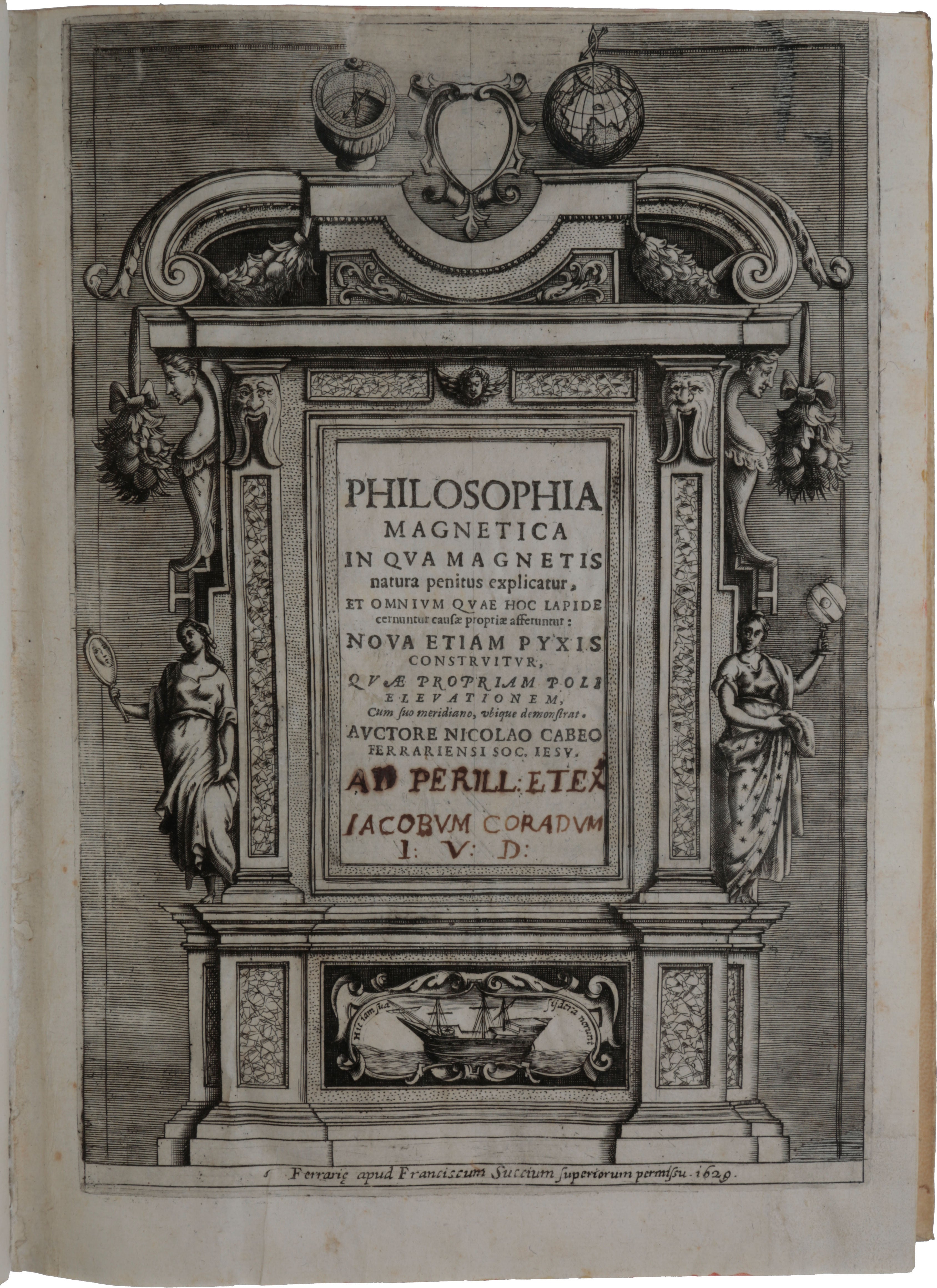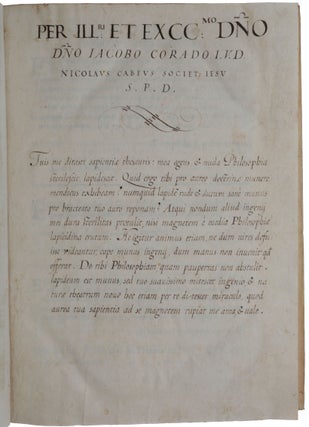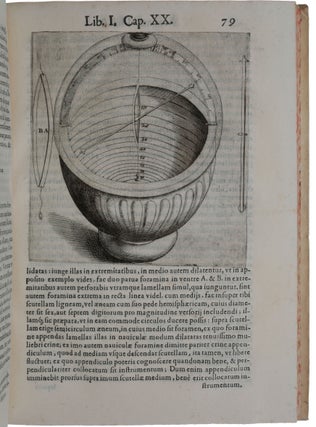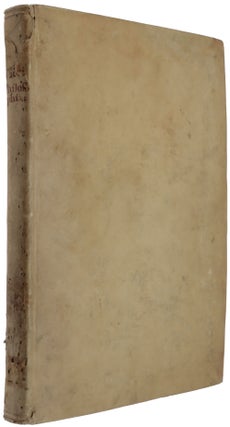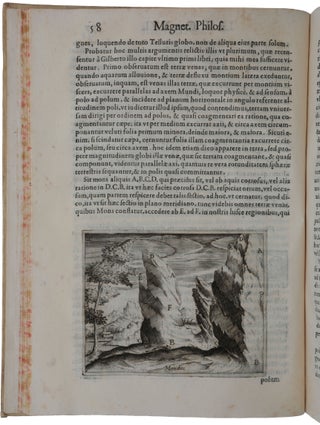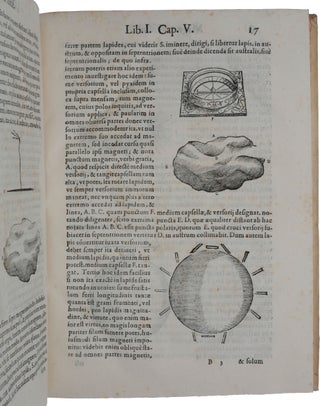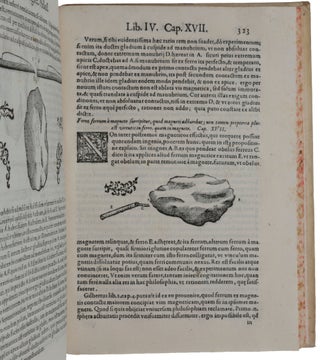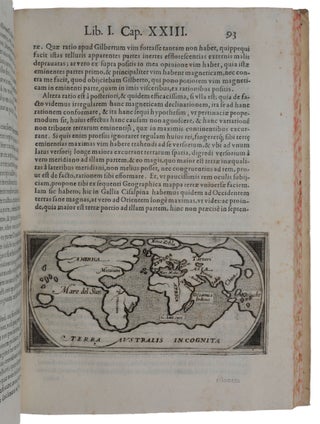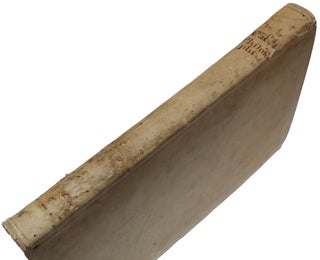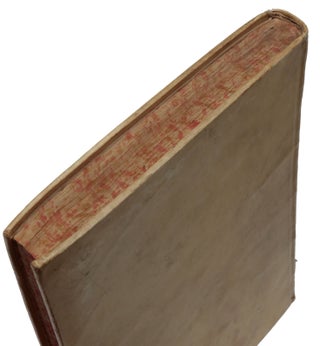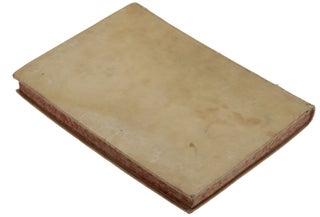Philosophia magnetica, in qua magnetis natura penitus explicatur, et omnium quae hoc lapide cernuntur, causae propriae afferuntur. Nova etiam pycis constrtuitur, quae propiam poli elevationem, sum suo meridiano, ubique demonstrat.
Ferrara: Francesco Suzzi, 1629. First edition, a unique pre-publication presentation copy by Cabeo to his teacher Jacobo Corrado, of the first extensive study of magnetism since William Gilbert’s De Magnete (1600). Corrado’s name is handwritten on the title page, which is in an unfinished state, the coat-of-arms at the head having been left un-engraved; in addition, there is an eleven-line manuscript dedication on the second leaf, which is blank but usually contains the Privilege of the Emperor Charles V. In the dedication Cabeo thanks his teacher and praises him for his vast knowledge. “His first book, the Philosophia magnetica, discussed not only Gilbert’s but also Cabeo’s own experimental investigations of terrestrial magnetism as well as magnetized iron and ‘lodestone’ (the mineral magnetite). The central focus of his work, like Gilbert’s before him, was therefore the study of the magnetic behaviors of compass needles. Where Gilbert, however, argued that the Earth itself is a giant magnet, whose poles reproduce the poles of an ordinary magnet and with which it interacts, Cabeo maintained instead that magnetic properties are inherent to certain sorts of matter; they did not subsist in their relationships to the great magnet, the Earth. Indeed, Cabeo denied that the Earth itself is a great magnet, even though it contains matter lending it magnetic effects. He also, again following Gilbert, discussed magnetic attraction between rubbed objects (typically, pieces of amber resin) and light objects such as bits of straw or paper; the attractive virtues of such electrified bodies appeared to be sufficiently similar to those of magnets that it seemed appropriate to investigate them together. In accounting for the production of electrical attraction by certain kinds of matter when they are rubbed, Cabeo—always, as a natural philosopher, on the lookout for causal explanations of phenomena, not simply their descriptions—suggested that the rubbing stimulates the emission of tiny particles, as an effluvium, from the rubbed body’s pores, which, in its interaction with the surrounding air, tends to move light objects toward it as a result of the rarified air’s subsequent behavior. In the Philosophia magnetica, Cabeo considered the methodological and epistemological issues relating to his experimental investigations. He stressed that his work sought the causes behind natural effects (this being the usual goal of Aristotelian-style natural philosophy) but that he would proceed by borrowing the approach of the mathematicians because it was so clear and demonstrative. He also stressed the extent to which his discussions were based upon experimental work, his experiments having been repeated numerous times, with multiple witnesses on hand to guarantee the truth of his reports. The necessity of saying such things stemmed from the unusual nature of the phenomena Cabeo described; neither magnetic nor electrical effects were generally familiar from everyday experience, and arguments based on unusual and contrived experimental behaviors therefore needed special justification to be accepted” (DSB). No presentation copy on ABPC/RBH. Cabeo (1586-1650) entered the Jesuit order as a novice in 1602. “Cabeo’s academic training occurred primarily at Parma, following the usual Jesuit curriculum of the period, and included the study of logic, natural philosophy (centered on the works of Aristotle), metaphysics, and theology; he clearly also studied some mathematics. Following the completion of his studies around 1616, Cabeo taught theology, philosophy, and metaphysics at Parma until 1621; he subsequently spent several years living at the Jesuit college back in Ferrara, his birthplace, and taught some theology there in the late 1620s. At the end of his life he returned to teaching, now at the Jesuit college in Genoa. In the meanwhile, he served the ducal courts in Mantua and in Modena, made use of his mathematical expertise in work on civil engineering projects, and was an itinerant preacher. He remained throughout his life engaged in issues of mathematics and natural philosophy, debating issues of mechanics, free fall, and motion with such contemporaries and familiars as Giovanni Battista Baliani, Benedetto Castelli, and Giovanni Battista Riccioli, as well as publishing his two major treatises. His interests covered a wide range of contemporary natural philosophy, however, beyond those questions of motion associated with his older contemporary Galileo” (ibid.). Although he was not in general a supporter of Galileo’s theories, he observed the experiments of Baliani on falling objects and agreed with Galileo that different objects fall the same distance in the same time regardless of their composition (Galilei, Opere, XVIII, 99 ff.). “Cabeo was a Jesuit, and like many Jesuits, he was interested in magnetism, because magnetism seemed to demonstrate the existence of occult properties, the hidden propensities of things to cause effects in other objects without an obvious means of action. Since a lodestone, or natural magnet, could magnetize a piece of iron, and then cause the iron object to move toward the lodestone, and itself to move toward the iron, this seemed to be a wonderful manifestation of occult properties. And the Jesuits were fascinated by occult effects … Cabeo seems to have admired Gilbert’s work, but he disagreed with Gilbert on a number of points, especially when Gilbert was critical of the Aristotelian approach to natural philosophy that had been adopted by most of the Jesuits. And he definitely did not agree, as Gilbert had concluded, that the earth’s magnetism caused it to rotate on its axis” (lindahall.org/niccolo-cabeo/). “In his discussion of terrestrial magnetism, Cabeo conceded that the whole Earth participated in magnetic virtue, but he objected strenuously to Gilbert’s assertion that the Earth was a big magnet. Gilbert had contended that at its core, the Earth was composed of a homogeneous and pure magnetic material which was to be found on the surface in an impure and less potent form. Cabeo held that the Earth’s magnetic field was demonstrably too small for such to be the case. For if, as Gilbert argued, a magnet’s power increased with its size, then the great Earth-magnet would snatch with utmost tenacity all ferrous bodies and imbed them in the core of the Earth. Similarly the great mass of the Earth-magnet would render negligible and unobservable the effects of all smaller loadstones on compass needles or iron objects. Furthermore, of the Earth were a perfect magnet, how could magnetic deviation be explained? If the sea covering the Earth blanketed or deflected the magnetic virtue, would not deviation then increase evenly with the distance one travelled away from land? Even Gilbert had acknowledged this was not the case. “After studying Gilbert’s arguments, Cabeo concluded that the Earth did possess magnetic force, but that this force was feeble. Opposing Gilbert, he reasoned that the Earth’s magnetic force was probably strongest at its surface and weakest at its core. Since a magnet received its powers of conservation and propagation from celestial influxes, superficial earthly parts would receive more of these influxes than interior parts. “When Cabeo considered why the whole Earth possessed magnetic force, however weak, his thinking was clearly shaped by the Aristotelian notion that nature endowed all things with the requisites for their conservation, propagation, and perfection. He asked how terrestrial magnetic force contributed to the Earth’s conservation and perfection. He argued that gravitational force held the Earth in the middle of the universe so that it could receive essential and vital influxes from the stars as they coursed around it. If some alien force or impetus produced by the swiftly rotating heavens should dislodge the Earth from its central position, the magnetic force would restore the Earth to its original position and gravity would resume its work. For Cabeo, the Earth occupied the physical centre of the universe in order to receive its stellar influxes in a proportionate manner. Gravitational force prevented the Earth from moving away from the centre of the cosmos, magnetic force maintained the attitude of the Earth’s axis … “After he had asserted that magnetic force was instrumental in maintaining the quiet of the Earth, Cabeo noted that ‘recentiores aloquos’ had used magnetic force to establish the mobility of the Earth. But rather than devote his book to the refutation of such opinions, he merely mentioned briefly that Gilbert’s arguments were being used by Copernicans” (Baldwin, pp. 157-8). Cabeo described electrical attraction in terms of electrical effluvia, released by rubbing certain materials together. These effluvia pushed into the surrounding air displacing it. When the air returned to its original location, it carried light bodies along with it making them move towards the attractive material. Both Accademia del Cimento and Robert Boyle performed experiments with vacuums in attempts to confirm or refute Cabeo’s ideas. Although electrical attraction had been described by Gilbert in De Magnete (London, 1600), Cabeo was the first to observe electrical repulsion. “Perhaps the most significant discovery of the century following Gilbert was that of electrical repulsion. This effect seems first to have been noticed incidentally by Cabeus, who, in his Philosophia Magnetica (1629), describes how filings attracted by excited amber sometimes recoiled to a distance of several inches after making contact” (Wolf, A History of Science, Technology, and Philosophy, I, p. 303). Cabeo also relates his many experiments on the possibility of telegraphic communication by means of magnetized needles and gives the first picture of the sympathetic telegraph, an imaginary magnetic telegraph which sometimes appeared in early electrical literature, fancifully prefiguring the actual telegraph. It was supposed to operate by synchronous activation of two instruments with alphabetic dials whose needles had been magnetized by the same magnet. Among the manywoodcutsin the textis, on page 316,"the firstrepresentationof thekindthatwe haveof themagneticfield"(Wheeler Gift), while page93 has an engraved world map (8 x 17 cm) showing the Americas, Europe, Africa, Asia and the TerraAustralisincognita(this is repeatedon p.220). “It used to be thought that Cabeo’s work on magnetism was original, but not that long ago (2006), a scholar rediscovered a manuscript of the 1580s by an earlier Jesuit, Leonardo Garzoni, who had done some quite original work on magnetism before Gilbert, but whose treatise had never been published. Cabeo discussed and praised Garzoni in his book, but he did not mention that huge chunks of his Philosophia magnetica had been lifted verbatim from Garzoni’s treatise. Plagiarism was not that uncommon in early modern scholarship, but such blatant and extensive plagiarism was a bit unusual, even for a 17th-century Jesuit. “The engraved title page to Cabeo’s book [has] an interesting emblem at the bottom, showing a ship with a huge compass on its foredeck, and the motto: Hic iam sua sydedra norunt, ‘Now here they have come to know their own stars,’ a clever way of suggesting that a compass allows the navigator to have his own North Star on his ship. Now that we know Cabeo’s scholarly propensities, it should come as no surprise that Cabeo borrowed the emblem from another source, in this case, the engraved title page of the second edition of Gilbert’s De magnete (1628), which had come out just the year before, and modified it just enough, adding a motto and moving the compass onboard ship, so that the inspiration was not obvious. The motto, incidentally, comes from Virgil’s Aeneid” (lindahall.org/niccolo-cabeo/). There are three issues of this book: the first issue has a royal coat-of-arms at the head of the title; the second issue has the coat-of-arms replaced by the Jesuit emblem; and the third was produced for export to Germany and has an added printed title with a Cologne imprint. In the present copy, the space where the coat-of-arms or Jesuit emblem would be printed has been left blank, and there is no printed title. Ferguson, Bibliotheca Chemica I, 136; Krivatsy 1988; Neville I 232; Riccardi I, 205-6; De Backer & Sommervogel II 483, 1; Heilbron, Electricity in the 17th Century (1999), 180; Mottelay, Bibliographical History of Electricity, 109; Wheeler Gift 97 (“the first recognition of electrical repulsion”); Sotheran 659 (“The first important work on electricity that appeared after Gilbert”). Baldwin, ‘Magnetism and the Anti-Copernican Polemic,’ Journal for the History of Astronomy 16 (1985), pp. 155-174.
Folio (296 x 215mm), pp. [xvi], 412, [12], engraved and woodcut illustrations in text (some light spotting, minor repair to the outer margin of the title page). Contemporary vellum, manuscript title on spine (some wormholes to the rear cover). A very large copy in the first state of printing.
Item #5178
Price: $55,000.00

